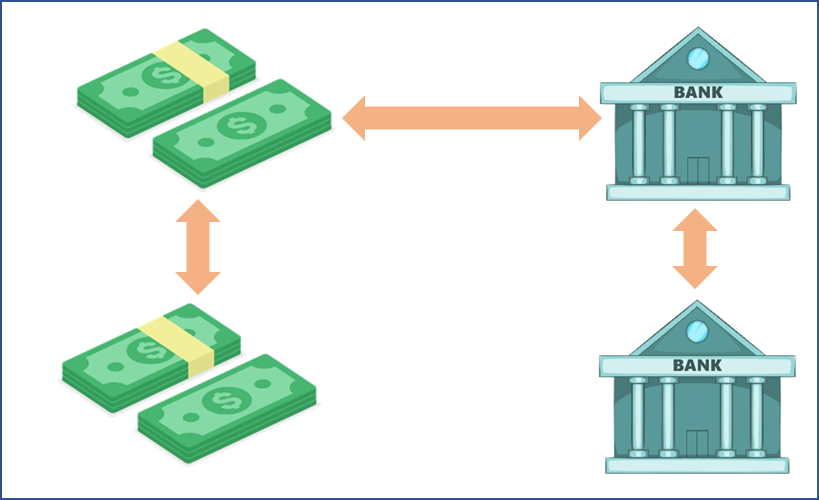- Introduction to Contra Entry
- Definition of Contra Entry
- Examples of Contra Entry
- Double Cash Book Format
Introduction to Contra Entry
‘Before we define contra voucher, let me tell you that this is something we deal day in and out. Did you withdraw cash from ATM? Have you visited your bank and deposited cash into your account? Did you transfer money from one bank account to another account of yours?
If you have done any of the above-mentioned events, you got to record it as contra entry. All the above-mentioned transactions are contra entry.
Definition of Contra Entry
Contra entry refers to transactions involving cash and bank account. In other words, any entry which affects both cash and bank accounts is called a contra entry. Contra in Latin means the opposite. It is more popularly known as contra voucher.
To make the definition further simpler, any transactions involving a transfer of cash between one cash a/c to another or one cash a/c to another bank a/c or one bank account to another is called as a contra entry.

As illustrated in the above image, the following is the list of contra transactions:
- Cash account to Bank account
- Bank account to Cash account
- Bank account to Bank account
- Cash account to Cash account
After looking at the above list, you might be wondering about the one which is the mentioned in the last i.e. ‘Cash account to Cash account’
To clear this confusion, we need to understand little more about ‘Petty Cash Account’.
It's usual business practice to maintain an account known as ‘Petty Cash’ with a small amount of cash to meet tiny expense such as courier, refreshments, stationeries etc. Whenever such small expenses are to be paid, the petty cash vouchers are used and paid from petty cash.
To fund this account, the cash is transferred from the main cash account to petty cash account. This when it is referred to as cash account to cash account.
The examples in the following section will make your understanding little deeper on contra entry.
Examples of Contra Entry
In the below table, we have mentioned different types of business transactions and some of them are contra entry. We have identified one’s which are contra entry with reason.
Remember the contra entry rule ‘Both Cash and Bank should be affected in any given transaction’
|
Entries |
Is it Contra Entry? |
Reasoning |
|
Transferred cash to petty cash 2,500 indo rupiah |
Yes |
Affects both two account - a Cash account and Petty cash |
|
Cash sales 1,750 Indo rupiah |
No |
Affects only one account - cash account |
|
Paid to Mr.Yash by cheque 3750 Indo rupiah |
No |
Affects only one account - cash account |
|
Received a cheque from M/s Zain and Bros., 4,500 paid into the bank |
No |
Cheque received is equivalent to cash. Affects only one account – Bank account |
|
Received cheque from Mr Alex 6,000 Indo rupiah paid into the bank |
No |
Cheque received is equivalent to cash. Affects only one account – Bank account |
|
Cash purchases 2,500 Indo rupiah |
No |
Affects only one account - cash account |
|
Paid rent by cheque 2,500 Indo rupiah |
No |
Affects only one account - cash account |
|
Cash is withdrawn from bank for office use 2,500 Indo rupiah |
Yes |
Affects two accounts – Cash and Bank account – |
|
Cash sales 3,750 Indo rupiah |
No |
Affects only one account - cash account |
|
Stationery purchased 1,000 Indo rupiah |
No |
Affects only one account - cash account |
|
Cash sales 6750 Indo rupiah |
No |
Affects only one account - cash account |
|
Deposited 10,000 Indo rupiah to the bank account |
Yes |
Affects two accounts – Cash and bank account – |
|
Withdrew cash for personal use 1,000 Indo rupiah |
No |
Affects only one account - cash account |
|
Salaries paid by cheque 9000 Indo rupiah |
No |
Affects only one account - cash account |
Double Cash Book Format
Double column cash book of Alex Enterprises
(Cashbook with cash and Bank column)
(Dr.). (Cr)
|
Date |
Particulars |
RN |
L.F |
Cash |
Bank |
Date |
Particulars |
RN |
L.F |
Cash |
Bank |
|
09.08 |
[Cash withdrawn from bank] |
|
C |
2,500 |
- |
09.08 |
By Cash |
|
C |
|
2,500 |
|
21.08 |
[Paid into bank] |
|
C |
- |
10,000 |
21.08 |
By Bank |
|
C |
10,000 |
|
To record contra entries, traditionally a cash book with cash and bank columns is prepared where both the aspects of the transaction will be entered in the same book which is Contra Book.
In the debit side of the contra book, ‘To Cash A/c’ will be entered under the particulars column and the amount will be entered in the bank column.
In the credit side of the contra book ‘By Bank A/c’ will be entered under the particulars column and the amount will be entered in the cash column.
And all such contra entries are denoted by writing the letter ‘C’ in the L.F. column, on both sides of the cash book. They represent that no posting in respect this is necessary in the ledger.
With automation of accounting using accounting software, these transactions are auto-posted into the relevant ledger and there is less relevance of cash book format discussed above.











